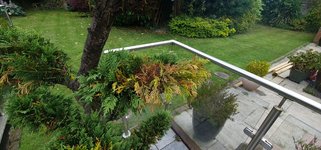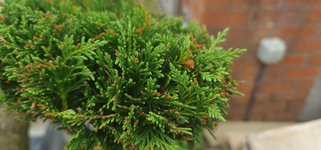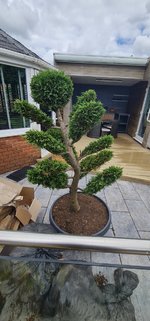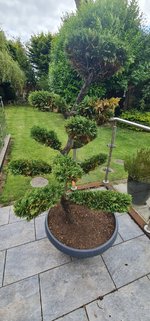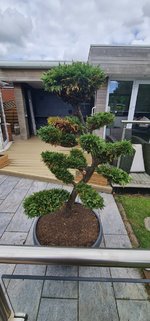You are using an out of date browser. It may not display this or other websites correctly.
You should upgrade or use an alternative browser.
You should upgrade or use an alternative browser.
Could somebody help with care for these bonsia
- Thread starter shane0
- Start date
pandacular
Masterpiece
The most important part of keeping these healthy is the correct amount of water and sunlight. Where are you located? Is it summer or winter? What amount of light do these trees get?
The soil looks organic and quite wet. I would aim to allow it to mostly dry out between waterings.
The soil looks organic and quite wet. I would aim to allow it to mostly dry out between waterings.
Shibui
Imperial Masterpiece
I would say these are more topiary than bonsai but they are trees in pots so we do have the knowledge.
First off, it will help to know what part of the world these trees are because many aspects of plants and care of depend on season and general climate. You can add a location to your personal profile so it pops up to remind us each time you post.
Now to brown needles.
Where exactly are the brown needles. Need some better photos of the problem area to be able to diagnose if you have a problem or if it is normal behaviour.
Do you know the species? Again, close up shot of foliage should let some of the experts here ID the species.
The trees are already a fair age. How long have you had them? Where did the come from? What have you done since you have had them at your place? The soil in the pots looks fresh? Repotted recently? If so how and what soil mix have you used.
Are they in shaded area or full sun? How often are you watering and how do you decide when to water?
Many questions I know but all that info could be relevant to any possible problem.
On the subject of fertilizer, These are trees. They cannot read the packets so will not care what fertiliser you use. Look for any complete fertiliser, especially if it is for potted plants.
First off, it will help to know what part of the world these trees are because many aspects of plants and care of depend on season and general climate. You can add a location to your personal profile so it pops up to remind us each time you post.
Now to brown needles.
Where exactly are the brown needles. Need some better photos of the problem area to be able to diagnose if you have a problem or if it is normal behaviour.
Do you know the species? Again, close up shot of foliage should let some of the experts here ID the species.
The trees are already a fair age. How long have you had them? Where did the come from? What have you done since you have had them at your place? The soil in the pots looks fresh? Repotted recently? If so how and what soil mix have you used.
Are they in shaded area or full sun? How often are you watering and how do you decide when to water?
Many questions I know but all that info could be relevant to any possible problem.
On the subject of fertilizer, These are trees. They cannot read the packets so will not care what fertiliser you use. Look for any complete fertiliser, especially if it is for potted plants.
shane0
Seedling
Thanks for the quick response. I'm in the UK- Manchester area and the weather is all over the place at the minute, we had a really dry spell a few weeks ago and I did my usual morning watering then same again in the late afternoon when the soil was dry up to my little finger. Now we have had a wet spell with rain for a few days so I'm wondering if the pots are not draining properly.
The trees come part of a package I got from Chelsea flower show(not sure on their name) so I'm guessing the soil should be good grade but I couldn't tell you what it is. All I've done is kept them tidy by pruning the long growths. I've not repotted or anything yet.
Our garden sits on the south side so it gets plenty of sun throughout the day.
The trees come part of a package I got from Chelsea flower show(not sure on their name) so I'm guessing the soil should be good grade but I couldn't tell you what it is. All I've done is kept them tidy by pruning the long growths. I've not repotted or anything yet.
Our garden sits on the south side so it gets plenty of sun throughout the day.
Orion_metalhead
Masterpiece
Close up photo of the foliage will definitely help.
shane0
Seedling

Thanks for the quick response. I'm in the UK- Manchester area and the weather is all over the place at the minute, we had a really dry spell a few weeks ago and I did my usual morning watering then same again in the late afternoon when the soil was dry up to my little finger. Now we have had a wet spell with rain for a few days so I'm wondering if the pots are not draining properly.
The trees come part of a package I got from Chelsea flower show(not sure on their name) so I'm guessing the soil should be good grade but I couldn't tell you what it is. All I've done is kept them tidy by pruning the long growths. I've not repotted or anything yet.
Our garden sits on the south side so it gets plenty of sun throughout the day.
Attachments
shane0
Seedling
I've posted a few pictures.I would say these are more topiary than bonsai but they are trees in pots so we do have the knowledge.
First off, it will help to know what part of the world these trees are because many aspects of plants and care of depend on season and general climate. You can add a location to your personal profile so it pops up to remind us each time you post.
Now to brown needles.
Where exactly are the brown needles. Need some better photos of the problem area to be able to diagnose if you have a problem or if it is normal behaviour.
Do you know the species? Again, close up shot of foliage should let some of the experts here ID the species.
The trees are already a fair age. How long have you had them? Where did the come from? What have you done since you have had them at your place? The soil in the pots looks fresh? Repotted recently? If so how and what soil mix have you used.
Are they in shaded area or full sun? How often are you watering and how do you decide when to water?
Many questions I know but all that info could be relevant to any possible problem.
On the subject of fertilizer, These are trees. They cannot read the packets so will not care what fertiliser you use. Look for any complete fertiliser, especially if it is for potted plants.
Orion_metalhead
Masterpiece
Its some variety of thuja. Foliage damage looks like sun scorch due to immediate exposure of new growth to sun in some spots and lack of sun in other spots. Id leave it alone and watch the watering to make sure it doesnt get too wet. If keeping in these pots, I'd consider checking roots next spring and, depending on soil and root situation, adjusting soil to be more well draining. If its not been recently repotted, fertilize with a balanced fertilizer 10-10-10 or similar.
See how reacts. Dont prune except for dead foliage and branches.
See how reacts. Dont prune except for dead foliage and branches.
Betula1
Mame
These look like recently imported plants -possibly Italian nursery stock. Imported into our cold wetter British "summer " weather doesnt help them but some of the browning could also be as a result of recent clipping to shape ,AKA cloud pruning . Browning is unlikely caused by sunscorch this summer in Britain!! They were likely rootballed then potted up before being sold on at Chelsea Flower show so possibly still recovering.- I bet they werent cheap LOL.
Orion_metalhead
Masterpiece
Very possible its not scorch. I know here in NJ that would be my first thought.These look like recently imported plants -possibly Italian nursery stock. Imported into our cold wetter British "summer " weather doesnt help them but some of the browning could also be as a result of recent clipping to shape ,AKA cloud pruning . Browning is unlikely caused by sunscorch this summer in Britain!! They were likely rootballed then potted up before being sold on at Chelsea Flower show so possibly still recovering.- I bet they werent cheap LOL.
shane0
Seedling
Do you recon I just keep my eyes on the soil for now and remove any dead parts? And quite a few K got chucked on the table that dayThese look like recently imported plants -possibly Italian nursery stock. Imported into our cold wetter British "summer " weather doesnt help them but some of the browning could also be as a result of recent clipping to shape ,AKA cloud pruning . Browning is unlikely caused by sunscorch this summer in Britain!! They were likely rootballed then potted up before being sold on at Chelsea Flower show so possibly still recovering.- I bet they werent cheap LOL.
shane0
Seedling
ThanksIts some variety of thuja. Foliage damage looks like sun scorch due to immediate exposure of new growth to sun in some spots and lack of sun in other spots. Id leave it alone and watch the watering to make sure it doesnt get too wet. If keeping in these pots, I'd consider checking roots next spring and, depending on soil and root situation, adjusting soil to be more well draining. If its not been recently repotted, fertilize with a balanced fertilizer 10-10-10 or similar.
See how reacts. Dont prune except for dead foliage and branches.
Shibui
Imperial Masterpiece
Sorry, but 10-10-10 is equal, NOT balanced, at least in fertiliser terms.balanced fertilizer 10-10-10 or similar.
In fertiliser speak, the term 'balanced' means it has all the major and minor nutrients required for plant growth as opposed to some products like urea or potassium sulphate which are also fertilisers but only have one or some of the nutrients needed by plants.
Misinterpretation of the term 'balanced' has led to demand for these crazy equal formulae fertilisers. No plants use NPK in equal ratios so a lot of what's in those fertilisers is waster and often contributes to soil and water pollution.
Plants require way more N than P or K so a reasonable fertiliser will have NPK around 5-1-2 or 5-1-3 (or multiples of those 10-2-4, etc)
The photos show browning in 2 different locations.
Brown tips are likely a reaction to recent mechanical trimming which cuts through individual needles, causing them to die or have brown ends. These plants were probably trimmed immediately before the show to make them look good. Those brown tips are almost certainly temporary. The dead needles will fall and new shoots will cover the remaining brown tips.
Brown interior and underneath can often be the old needles reaching end of life. Each individual leaf (needle) has a finite lifespan of 2-3 years then they are less productive so the tree lets them turn brown, die and then drop off. In the meantime new needles have grown as the twigs grow so the tree always has plenty of healthy, productive foliage.
The large brown patch at the end of the branch is more concerning and probably indicates some trauma. Could be physical damage from rough handling. Could be lack of water at some stage in the past month or so (evergreens are often very slow to show the results of trauma so we sometimes forget what happened)
Provided the trees are getting enough water and light I don't think there's anything else you can do to reverse this damage. Wait to see if the problem spreads or stabilizes. If it continues to get worse I would contact the seller and look for answers and/or refund.
The damages areas are likely already dead. If the brown stops spreading you can follow the dead branches back to where it meets the live part and prune off any obvious dead sections. Those branches will look odd for a year or 2 but, with good care, the live parts will grow and eventually fill out the branch again.
Orion_metalhead
Masterpiece
Fair correction!Sorry, but 10-10-10 is equal, NOT balanced, at least in fertiliser terms.
In fertiliser speak, the term 'balanced' means it has all the major and minor nutrients required for plant growth as opposed to some products like urea or potassium sulphate which are also fertilisers but only have one or some of the nutrients needed by plants.
Misinterpretation of the term 'balanced' has led to demand for these crazy equal formulae fertilisers. No plants use NPK in equal ratios so a lot of what's in those fertilisers is waster and often contributes to soil and water pollution.
Plants require way more N than P or K so a reasonable fertiliser will have NPK around 5-1-2 or 5-1-3 (or multiples of those 10-2-4, etc)
shane0
Seedling
Sorry, but 10-10-10 is equal, NOT balanced, at least in fertiliser terms.
In fertiliser speak, the term 'balanced' means it has all the major and minor nutrients required for plant growth as opposed to some products like urea or potassium sulphate which are also fertilisers but only have one or some of the nutrients needed by plants.
Misinterpretation of the term 'balanced' has led to demand for these crazy equal formulae fertilisers. No plants use NPK in equal ratios so a lot of what's in those fertilisers is waster and often contributes to soil and water pollution.
Plants require way more N than P or K so a reasonable fertiliser will have NPK around 5-1-2 or 5-1-3 (or multiples of those 10-2-4, etc)
The photos show browning in 2 different locations.
Brown tips are likely a reaction to recent mechanical trimming which cuts through individual needles, causing them to die or have brown ends. These plants were probably trimmed immediately before the show to make them look good. Those brown tips are almost certainly temporary. The dead needles will fall and new shoots will cover the remaining brown tips.
Brown interior and underneath can often be the old needles reaching end of life. Each individual leaf (needle) has a finite lifespan of 2-3 years then they are less productive so the tree lets them turn brown, die and then drop off. In the meantime new needles have grown as the twigs grow so the tree always has plenty of healthy, productive foliage.
The large brown patch at the end of the branch is more concerning and probably indicates some trauma. Could be physical damage from rough handling. Could be lack of water at some stage in the past month or so (evergreens are often very slow to show the results of trauma so we sometimes forget what happened)
Provided the trees are getting enough water and light I don't think there's anything else you can do to reverse this damage. Wait to see if the problem spreads or stabilizes. If it continues to get worse I would contact the seller and look for answers and/or refund.
The damages areas are likely already dead. If the brown stops spreading you can follow the dead branches back to where it meets the live part and prune off any obvious dead sections. Those branches will look odd for a year or 2 but, with good care, the live parts will grow and eventually fill out the I would of looked like a right idiot going through all them fertilisers they hadI went for 5-1-3 so fingers crossed it survives this hard time it's going through, ill keep a close eye on the browning, is it best to let them needles fall naturally or can I remove by hand.
Desert O'Piñon
Omono
This seems like a good thread to stick my nosey question into. This was identified as a thuja. Is this the same as arbovitae and white cedar? Sorry, but this is one of MANY, MANY questions I want to learn. So glad I found this community!
Shibui
Imperial Masterpiece
Arbovitae is one of the common names for the 5 Thuja species so, yes, same plant family.This was identified as a thuja. Is this the same as arbovitae and white cedar?
Thuja occidentalis is also known as Northern white cedar. The other species have different common names.
Please note that the same species may have different common names in different states or parts of it's range and different plants in different parts of the world may have the same common name.
White cedar is a conifer in North America but Melia azaderach (AKA Chinaberry) is also known as white cedar though they look nothing alike and from different plant families from different parts of the world.
It is always safest to find and use the plant's proper, scientific name which means far less confusion.
Betula1
Mame
Provided the trees are getting enough water and light I don't think there's anything else you can do to reverse this damage. Wait to see if the problem spreads or stabilizes. If it continues to get worse I would contact the seller and look for answers and/or refund.
Shibui's suggestion is spot on!
Plants are sold off after Chelsea Flower show each year at exorbitant prices
The garden designers there are just there to promote and showcase their garden designs and then make a fast buck ,but they won't want the bad publicity from being found to be selling dodgy plants imported from European nurseries! The least they can do is provide advice and if all else fails, should give you a refund.
Shibui's suggestion is spot on!
Plants are sold off after Chelsea Flower show each year at exorbitant prices
The garden designers there are just there to promote and showcase their garden designs and then make a fast buck ,but they won't want the bad publicity from being found to be selling dodgy plants imported from European nurseries! The least they can do is provide advice and if all else fails, should give you a refund.
shane0
Seedling
Thanks for all the help it's much appreciated, do you think it's a good idea to cut back any dead parts or shall I just keep on top of the watering and fertiliser for now.Sorry, but 10-10-10 is equal, NOT balanced, at least in fertiliser terms.
In fertiliser speak, the term 'balanced' means it has all the major and minor nutrients required for plant growth as opposed to some products like urea or potassium sulphate which are also fertilisers but only have one or some of the nutrients needed by plants.
Misinterpretation of the term 'balanced' has led to demand for these crazy equal formulae fertilisers. No plants use NPK in equal ratios so a lot of what's in those fertilisers is waster and often contributes to soil and water pollution.
Plants require way more N than P or K so a reasonable fertiliser will have NPK around 5-1-2 or 5-1-3 (or multiples of those 10-2-4, etc)
The photos show browning in 2 different locations.
Brown tips are likely a reaction to recent mechanical trimming which cuts through individual needles, causing them to die or have brown ends. These plants were probably trimmed immediately before the show to make them look good. Those brown tips are almost certainly temporary. The dead needles will fall and new shoots will cover the remaining brown tips.
Brown interior and underneath can often be the old needles reaching end of life. Each individual leaf (needle) has a finite lifespan of 2-3 years then they are less productive so the tree lets them turn brown, die and then drop off. In the meantime new needles have grown as the twigs grow so the tree always has plenty of healthy, productive foliage.
The large brown patch at the end of the branch is more concerning and probably indicates some trauma. Could be physical damage from rough handling. Could be lack of water at some stage in the past month or so (evergreens are often very slow to show the results of trauma so we sometimes forget what happened)
Provided the trees are getting enough water and light I don't think there's anything else you can do to reverse this damage. Wait to see if the problem spreads or stabilizes. If it continues to get worse I would contact the seller and look for answers and/or refund.
The damages areas are likely already dead. If the brown stops spreading you can follow the dead branches back to where it meets the live part and prune off any obvious dead sections. Those branches will look odd for a year or 2 but, with good care, the live parts will grow and eventually fill out the branch again.
shane0
Seedling
Definitely will do if they don't pull through, I'll keep watering and keep ontop of my fertiliser, fingers crossed its something and nothing.Provided the trees are getting enough water and light I don't think there's anything else you can do to reverse this damage. Wait to see if the problem spreads or stabilizes. If it continues to get worse I would contact the seller and look for answers and/or refund.
Shibui's suggestion is spot on!
Plants are sold off after Chelsea Flower show each year at exorbitant prices
The garden designers there are just there to promote and showcase their garden designs and then make a fast buck ,but they won't want the bad publicity from being found to be selling dodgy plants imported from European nurseries! The least they can do is provide advice and if all else fails, should give you a refund.
Similar threads
- Replies
- 2
- Views
- 860
- Replies
- 9
- Views
- 811
- Replies
- 3
- Views
- 816
- Replies
- 1
- Views
- 695



